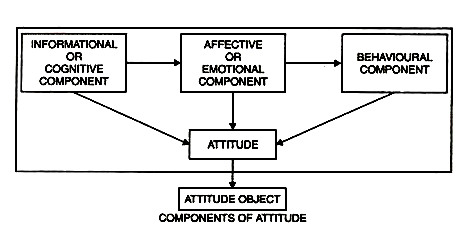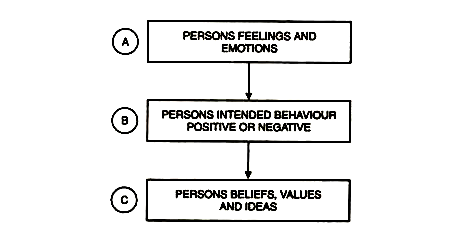An Attitude may be defined as a feeling or disposition to favour or to be against objects, persons and situations. An attitude is a well defined object of reference.
“An attitude is a dispositional readiness to respond to certain institutions, persons or objects in a consistent manner which has been learnt and has become one’s typical mode of response.” —Frank Freeman
“An attitude denotes the sum total of man’s inclinations and feelings, prejudice or bias, pre-conceived notions, ideas, fears, threats and other any specific topic.” —Thurstone
“An attitude is defined as a tendency to react favourably or unfavourably towards a designated class of stimuli, such as a national or racial group, a custom or an institution.” —Anastasi
Characteristics/Features of an Attitude
An attitude has the following features/characteristics with it.
These are given below:
- An attitude is a learned tendency. So it can be learnt.
- It is a point or object of reference.
- It includes certain aspects of personality as interests, appreciations and social conduct.
- An attitude is adopted.
- An attitude indicates the sum total of a man’s inclinations and feelings.
- An attitude is a point of view, substantiated or otherwise, true or false which one holds towards an idea, object or person.
- An attitude has aspects such as direction, intensity, generality or specificity.
- An attitude refers one’s readiness for doing work.
Components of Attitudes
Attitudes comprise of three basic components: emotional, informational and behavioural.
These three components are described below:
- Informational or Cognitive Component
The informational component consists of beliefs, values, ideas and other information a person has about the object. It makes no difference whether or not this information is empirically correct or real. For example, a person seeking a job may learn from his own sources and other employees working in the company that in a particular company the promotion chances are very favourable. In reality, it may or may not be correct. Yet the information that person is using is the key to his attitude about that job and about that company.
- Emotional or Affective Component
The informational component sets the stage for the more critical part of an attitude, its affective component. The emotional components involve the person’s feeling or affect-positive, neutral or negative-about an object. This component can be explained by this statement.” I like this job because the future prospects in this company are very good”.
- Behavioural Component
The behavioural component consists of the tendency of a person to behave in a particular manner towards an object. For example, the concerned individual in the above case may decide to take up the job because of good future prospects. Out of the three components of attitudes, only the behavioural component can be directly observed. One cannot see another person’s beliefs (the informational component) and his feelings (the emotional component). These two components can only be inferred. But still understanding these two components is essential in the study of organizational behaviour or the behavioural component of attitudes.

ABC Model of Attitude
All the three components of attitude explained above constitute, what is OF called the ABC model. Here, in the ABC model, the alphabet A stands for Affective component, B for Behavioural and C for the cognitive component. The importance of this model is that to have a proper and thorough understanding of the concept of attitude, all the three components mentioned above must be properly assessed. It is only the behavioural component which can be directly observed, the other two components: affective and cognitive can however only be inferred.

Uses of Attitude Scale
Before discussing the uses of these two methods of assessment of attitude, it is necessary to give a brief view of these two methods. “The Likert Method succeeds the Thorstone’s method and was considered on improvement over the latter. Justifying the need for devising a new method Murphy and Likert point out, “A number of statistical assumptions are made in the application of his (Thurstone’s) attitude scales that the scale values of the statements are independent of the attitude distribution of the readers who sort out the statements – assumptions which as Thurstone points out, can’t always be verified. The method is more over laborious.
It seems legitimate to enquire whether it actually does its work better than the simple scales which may be employed and in the same breath to ask whether it is not possible to construct equally reliable scales without making unnecessary statistical assumptions.”
So accordingly, the uses of these two attitude scales are given below:
- Attitudes do have a stronger role in an individual’s success on any job or activity.
- They provide necessary information to the teacher about pupils’ attitude. Accordingly, the teacher and guidance personnel can provide assistance to individual in selection of occupation and further study.
- From attitude scales the teacher and guidance worker can know and understand the pupils individually. On its basis, they can be able to change the negative attitude of pupils into positive one.
- Attitude scales are employed to identify the extent to which positive and desirable attitudes have been developed, in individuals.
- Attitude offers potent possibilities of achievement as well as failure in life.
- Through inculcation of desirable interest, positive attitude in individual can be developed by the guidance personnel.
- These are used to identify attitude patterns of individual and guidance programme is arranged as per the need of the individual.
Limitations of Attitude Scale
- Attitude is a complex affair which can’t be wholly described by any single numerical complex.
- Attitude is subject to change. So what is measured today about a student’s attitude may not indicate his future attitude towards the subject or occupation.
- Students sometimes give vague responses to items on an attitude scale. It is not always and in all cases possible to get real attitude of a student.
- Generally pupils or students are trained to give tick marks on the middle of the scale. So their responses don’t reveal the true dimension of their attitudes.
- Discrepancy is noticed in student’s expressed attitude and tested attitude. Hence tested attitude isn’t always dependable.
One thought on “Attitude”